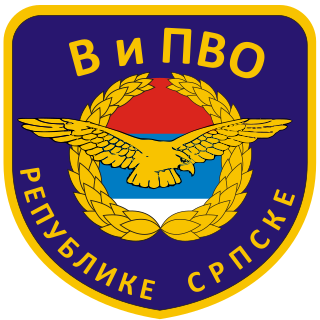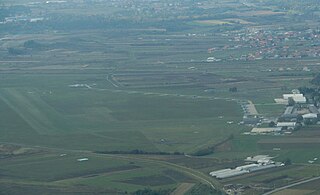
The Slovenian Armed Forces or Slovenian Army are the armed forces of Slovenia. Since 2003, it is organized as a fully professional standing army. The Commander-in-Chief of the SAF is the President of the Republic of Slovenia, while operational command is in the domain of the Chief of the General Staff of the Slovenian Armed Forces.

"Naprej, zastava slave" or "Naprej, zastava Slave" is a former national anthem of Slovenia, used from 1860 to 1989. It is now used as the official service song of the Slovenian Armed Forces and as the anthem of the Slovenian nation.

Ljubljana Jože Pučnik Airport, also known by its previous name Brnik Airport, is the international airport serving Ljubljana and the largest airport in Slovenia. It is located near Brnik, 24 km (15 mi) northwest of Ljubljana and 9.5 km (5.9 mi) east of Kranj, at the foothills of Kamnik–Savinja Alps.

Novi Sad Airfield, also known as Čenej Airfield, is located near the village of Čenej in Vojvodina, Serbia. The site is mostly used for sport and agriculture, operated by Aero Club Novi Sad.

The Air Force and Air Defence, was one of three branches of the Yugoslav People's Army, the Yugoslav military. Commonly referred-to as the Yugoslav Air Force, at its height it was among the largest in Europe. The branch was disbanded in 1992 after the Breakup of Yugoslavia. In the year 1990, the Air Force had more than 32,000 personnel, but as a result of its more technical requirements, the Air Force had less than 4,000 conscripts.

The Republika Srpska Air Force was the air force of Republika Srpska and was used primarily during the Bosnian war. In 2005, it was integrated into the Armed Forces of Bosnia and Herzegovina. SFOR still plays a large role in Bosnia and Herzegovina, which consists of the Federation of Bosnia and Herzegovina and Republika Srpska. Under the leadership of one president, the ministry of defense of both entities merged into one single ministry of defense with one chief of joint staff commanding both Air Forces. In 2004 there was again a restructuring of the armed forces, bringing the number of Air Force personnel down to 4,000. Next to the command, the 1st Regiment V i PVO consists out of a platoon, a radar battalion, artillery rocket ADF battalion, AF logistics battalion and aviation assets, a Fighter Bomber Squadron and Mixed Helicopter Squadron. In 2006 the Air Force of Republika Srpska was disbanded.

Cerklje ob Krki is a settlement on the left bank of the Krka River in the Municipality of Brežice in eastern Slovenia. It is best known for the Cerklje ob Krki Airport north of the settlement. The area is part of the traditional region of Lower Carniola. It is now included in the Lower Sava Statistical Region.

Lučko Airfield is an airfield for general aviation and unscheduled air transport, located in Ježdovec near Lučko, in central Croatia, 11 kilometres (6.8 mi) southwest of Zagreb. It is operated by Aeroklub Zagreb and has two parallel grass runways measuring 850 by 30 metres. Due to the lack of surfacing on the runways, it is only used from spring to autumn in dry periods. Aside from traffic, the airport is today a venue for air shows, such as Zagreb Air Show and Adria Air Race and an operation base for civilian pilot training.

Slovenian Air Force and Air Defence is a part of the Slovenian Armed Forces. It is an integral part of the command structure, not an independent branch.
Jernej Molan Barracks, also known as the barracks at Cerklje ob Krki Krka, is a barracks of the Slovenian Armed Forces, which is located in Cerklje ob Krki, Slovenia.
Hrastje pri Cerkljah is a small village northwest of Cerklje ob Krki in the Municipality of Brežice in eastern Slovenia. The area is part of the traditional region of Lower Carniola. It is now included in the Lower Sava Statistical Region.
The 116th Fighter Aviation Regiment was a unit originally established in 1944 as the 113th Fighter Aviation Regiment. It was formed from Yugoslav partisan aviators, trained and equipped by the Soviet Air Force.
The 96th Fighter-Bomber Aviation Regiment was established in 1944 as the 423rd Assault Aviation Regiment, It was formed from Yugoslav partisan aviators and trained and equipped by the Soviet Air Force.
The 82nd Aviation Brigade was a Yugoslavian aviation regiment established in 1945 as 42nd Bomber Aviation Regiment.
The 117th Fighter Aviation Regiment was a unit established in 1944 as the 112th Fighter Aviation Regiment. It was formed from Yugoslav partisan aviators, who were trained and equipped by the Soviet Air Force. The regiment was deployed in the Croatian War of Independence, and is believed to be responsible of the 1991 raid on Vrsar.
The 111th Helicopter Regiment was a unit established in 1944 as the 422nd Assault Aviation Regiment.

The Municipality of Brežice is a municipality in eastern Slovenia in the Lower Sava Valley along the border with Croatia. The seat of the municipality is the town of Brežice. The area was traditionally divided between Lower Styria and Lower Carniola. The entire municipality is now included in the Lower Sava Statistical Region.
The 894th Helicopter Reconnaissance and Liaison Squadron was an aviation squadron of the Yugoslav Air Force formed in 1952 at Borongaj airfield as the Liaison Squadron of 5th Military district.
Šoštanj Airport is a small airport located in the settlement of Topolšica, Slovenia. It lies 2.2 kilometers (1.4 mi) north of Šoštanj and 6.2 kilometers (3.9 mi) northwest of Velenje. Given its short asphalt runway, the airport serves only small general aviation aircraft, up to 5,670 kilograms (12,500 lb) MTOM. Heavier aircraft can land at the discretion of the PIC if the performance is adequate. Examples of the heaviest aircraft operated at LJSO are Slovenian Air Force Cougar at 9000 kg MTOM, Solinair Turbolet 410 at 6600 kg MTOM, and Gorenje Cessna Citation I 5375 kg MTOM. The airport is maintained by Šaleški Aeroklub.
This article represents the structure of the Slovenian Armed Forces since the military reform in 2013.














